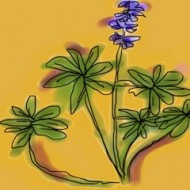The Dry Garden: Eco-snooping, part two
It was a hybrid call of the wild that Gilda Garcia heard when she decided to do a native garden in the frontyard of her North Hollywood home in 2006. As she recalled it during a mid-March visit, “The challenge was how could you mix native plants, Mexican art and poodles?”
It would be a spoiler to use anything but a detail shot from what is a truly fabulous before-and-after photo spread put together by Garcia and Los Angeles Times photographer Anne Cusack for this week’s “The Dry Garden” column.
So, click here to see how Garcia transformed her garden from lawn and three hedges into “Poodleville” in the Los Angeles Times and to read the second installment of the three-part series previewing properties on the Theodore Payne Foundation Tour, April 10-11.…
The Dry Garden: Eco-snooping
Yes, yes, yes. We all know that native gardens save water, curb greenhouse gas pollution, save homeowners thousands a year on mow and blow fees and entitle their owners to eco-sainthood. But what do they look like? Are they beautiful? If so, are they hard to plant and maintain? Where can you put down the baby? Will those who might want one still be allowed a patch of lawn?
To help Los Angeles homeowners see the almost endless possibilities open after they start incorporating local flora into their gardens, the Theodore Payne Foundation for Wildflowers and Native Plants calls upon its members every spring to open their homes to the public. The upshot is a tour in which the smartest, most experienced native gardeners in Southern California get down with whoever shows up asking for help.
Click here to keep reading the first of a three part series as the …
The Dry Garden: What’s that bug?
Pterotus obscuripennis. Source: Santa Barbara Museum of Natural History. Click on the telltale feathery antennae to be taken to the museum's Beetle Project.
Three things happen when you plant a garden. You meet your neighbors, who stop to chat. You meet their kids, who hang out. And you meet the bugs that the kids find. The ability to identify the bugs ensures you heroic status in the eyes of children. Failure to identify them is a crashing experience not to be wished upon one’s worst enemy.
Click here to keep reading the Dry Garden column in the Los Angeles Times as Cal State Northridge entomologist James N. Hogue gives tips on identifying bugs for kids.
Hogue is co-author with Arthur V. Evans of “Field Guide to Beetles of California.” Click here to find out about Hogue’s April 3 class “Insects and Native Plant Gardens” at the Theodore …
The Dry Garden: “Spontaneous urban vegetation”
Weeds do so much cooling, aerating and stabilizing of vacant lots and roadsides that Harvard horticulturist Peter Del Tredici has taken to celebrating them as “spontaneous urban vegetation.”
But when a mother lode of seed from these fast-breeding, water-hungry plants germinates in a garden, particularly a drought-tolerant garden in Southern California, it’s war. It’s a water war.
By weeding after winter rains, you can allocate water to the right plants and cut off the thirsty interlopers. You’ll snare the seeds of weeds before they can spread. You’ll also clear out a sweaty little under-zone of greedy greens that block air and light from the plants that you want to thrive.
Click here to keep reading The Dry Garden in the Los Angeles Times. Or click here to read about Tredici’s intriguing new book “Wild urban plants of the northeast,” keeping in mind that, thanks to us, many of …
The Dry Garden: Protecting the Pacific
What, you might ask, does the ocean have to do with gardening? In California, Orange County landscape designer Douglas Kent would reply: Everything. All the rain that we don’t catch during the winter and all of the irrigation spilled into the streets from our sprinklers in the warm months end up as storm water. “Water running into the ocean is not inherently harmful,” Kent writes in his new book Ocean Friendly Gardens. “It is the stuff attached to it and the stuff it picks up on the way to the ocean that is. Fertilizers, pesticides, oils, cleaning solutions and organic debris all run off a landscape.”
Click here to keep reading about Kent’s new book published by the Surfrider Foundation in the “The Dry Garden” column of the Los Angeles Times …
« go back — keep looking »

